
Abruzzo, historically known as Abruzzi, is a region of Southern Italy with an area of 10,763 square km and a population of 1.3 million. It is divided into four provinces: L'Aquila, Teramo, Pescara, and Chieti. Its western border lies 80 km (50 mi) east of Rome. Abruzzo borders the region of Marche to the north, Lazio to the west and north-west, Molise to the south and the Adriatic Sea to the east. Geographically, Abruzzo is divided into a mountainous area in the west, which includes the highest massifs of the Apennines, such as the Gran Sasso d'Italia and the Maiella, and a coastal area in the east with beaches on the Adriatic Sea.

L'Aquila is a city and comune in central Italy. It is the capital city of both the Abruzzo region and of the Province of L'Aquila. As of 2023, it has a population of 69,558 inhabitants. Laid out within medieval walls on a hill in the wide valley of the Aterno river, it is surrounded by the Apennine Mountains, with the Gran Sasso d'Italia to the north-east.

The province of L'Aquila is the largest, most mountainous and least densely populated province of the Abruzzo region of Italy. It comprises about half the landmass of Abruzzo and occupies the western part of the region. It has borders with the provinces of Teramo to the north, Pescara and Chieti to the east, Isernia to the south and Frosinone, Rome and Rieti to the west. Its capital is the city of L'Aquila.
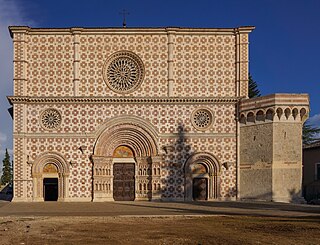
Santa Maria di Collemaggio is a large medieval church in L'Aquila, central Italy. It was the site of the original Papal Jubilee, a penitential observation devised by Pope Celestine V, who is buried there. The church, which therefore ranks as a basilica because of its importance in religious history, sits in isolation at the end of a long rectangular sward of grass at the southwest edge of the town.
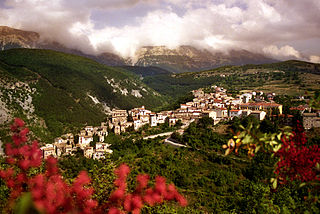
Cansano is a comune in the province of L'Aquila in the Abruzzo region, Southern Italy. It is part of the Maiella National Park. Cansano is known for the archaeological discovery of the Italic and Roman town of Ocriticum, which has become an archaeological park.

Cocullo is a comune and town in the Province of L'Aquila, located in the Abruzzo region of Italy. As of 2013 its population was of 246.

Molina Aterno is a comune and town in the province of L'Aquila in the Abruzzo region of central Italy. The name derives from Latin molina ("mill"), the second part having been added in 1889 due to the presence of the Aterno river.
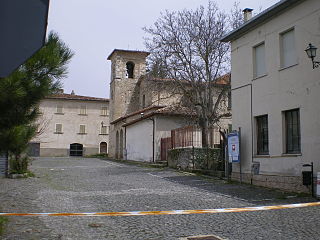
Ocre is a comune (municipality) and town in the province of L'Aquila in the Abruzzo region of southern Italy.
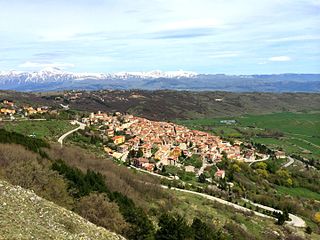
Rocca di Cambio is a comune and town in the province of L'Aquila in the Abruzzo region of Italy.

Santo Stefano di Sessanio is a comune and hill town in the province of L'Aquila in the Abruzzo region of southern Italy. Located in the Gran Sasso e Monti della Laga National Park, in the highest region of the Apennines, this medieval hill town sits adjacent to the high plain of Campo Imperatore. It is one of I Borghi più belli d'Italia.
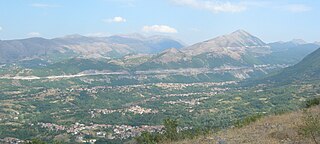
Tornimparte is a comune and town in the province of L'Aquila in the Abruzzo region of central-southern Italy.

Villa Sant'Angelo is a comune and town in the province of L'Aquila, in the Abruzzo region of Italy, which lies in the Aterno River valley near the convergence of the Sirente and the Gran Sasso mountain ranges. Many of the municipal functions are managed cooperatively with adjacent villages, comprising the Comunità Montana Amiternina.

Paganica is a hillside town in the province of L'Aquila, in the Abruzzo region of southern Italy. located at 669 meters above sea level, at the foot of the Gran Sasso d'Italia, about 7 kilometers east of the historic center, along the state road 17 bis that from Bazzano climbs to Campo Imperatore passing for Tempèra, Camarda, Assergi and Fonte Cerreto, with a population of about 5 000 inhabitants, making it the largest fraction of the city, as well as of considerable economic importance. It is a frazione of the comune of L'Aquila, and has a population of about 5,000.

An earthquake occurred in the region of Abruzzo, in central Italy, at 03:32 CEST on 6 April 2009. It was rated 5.8 or 5.9 on the Richter magnitude scale and 6.3 on the moment magnitude scale; its epicentre was near L'Aquila, the capital of Abruzzo, which together with surrounding villages suffered the most damage. There were several thousand foreshocks and aftershocks since December 2008, more than thirty of which had a Richter magnitude greater than 3.5.
San Gregorio is a village in the Abruzzo region of central Italy. It is a frazione of the comune of L'Aquila. It sits 584 meters above sea level at the base of Monte Manicola. The village of San Gregorio is 12.11 kilometers from the town of L'Aquila, of which it is considered a suburb community. Italy's SS17 Highway is its main transportation artery. The village sits near an active earthquake fault zone in the Valley of the Aterno-Pescara.

Sassa is a frazione in the Province of L'Aquila in the Abruzzo region of Italy. After the 2009 L'Aquila earthquake, it has a population of about 2500 inhabitants considering small villages around this frazione.

Chiesa di Santa Maria ad Cryptas is a Middle Ages church in Fossa, Province of L'Aquila (Abruzzo).
The following is a timeline of the history of the city of L'Aquila in the Abruzzo, a region of Italy.
On 27 November 1461, a powerful earthquake and series of aftershocks struck Italy's Abruzzo region along the Aterno River. The tremors caused widespread damage to Abruzzo's capital, L'Aquila, and the surrounding villages. At least 80 people are recorded to have died and numerous people were injured by the earthquakes. The quakes also caused major, permanent damage to religious sites and changed politics for L'Aquila and the Abruzzo region.
The 1706 Abruzzo earthquake, also known as the Maiella earthquake, occurred on November 3 at 13:00 CEST. The earthquake with a possible epicenter in the Central Apennine Mountains (Maiella), Abruzzo had an estimated moment magnitude of 6.6–6.84 Mw . It was assigned a maximum Mercalli intensity of XI (Extreme), causing tremendous destruction in Valle Peligna. At least 2,400 people were killed.




















